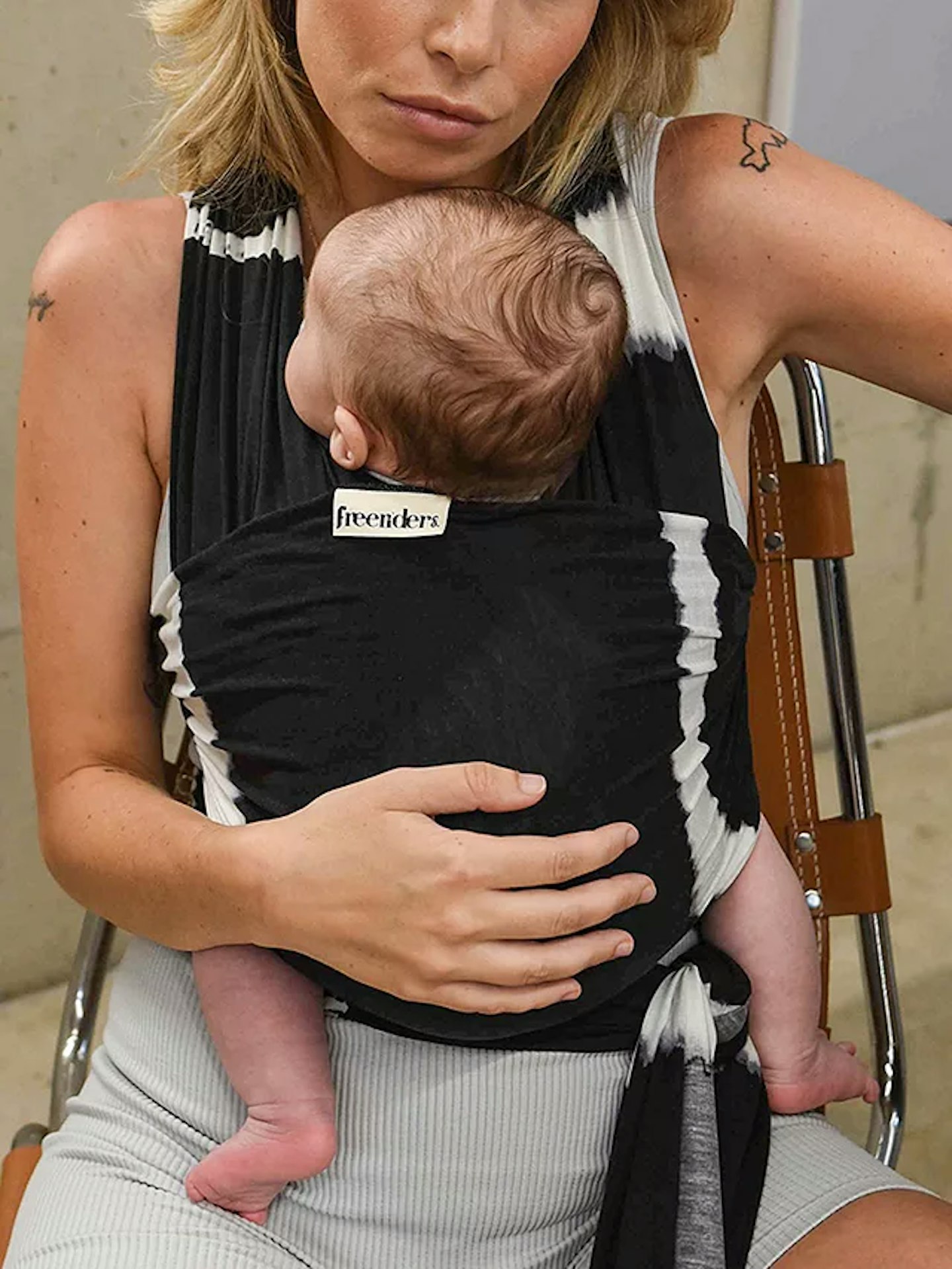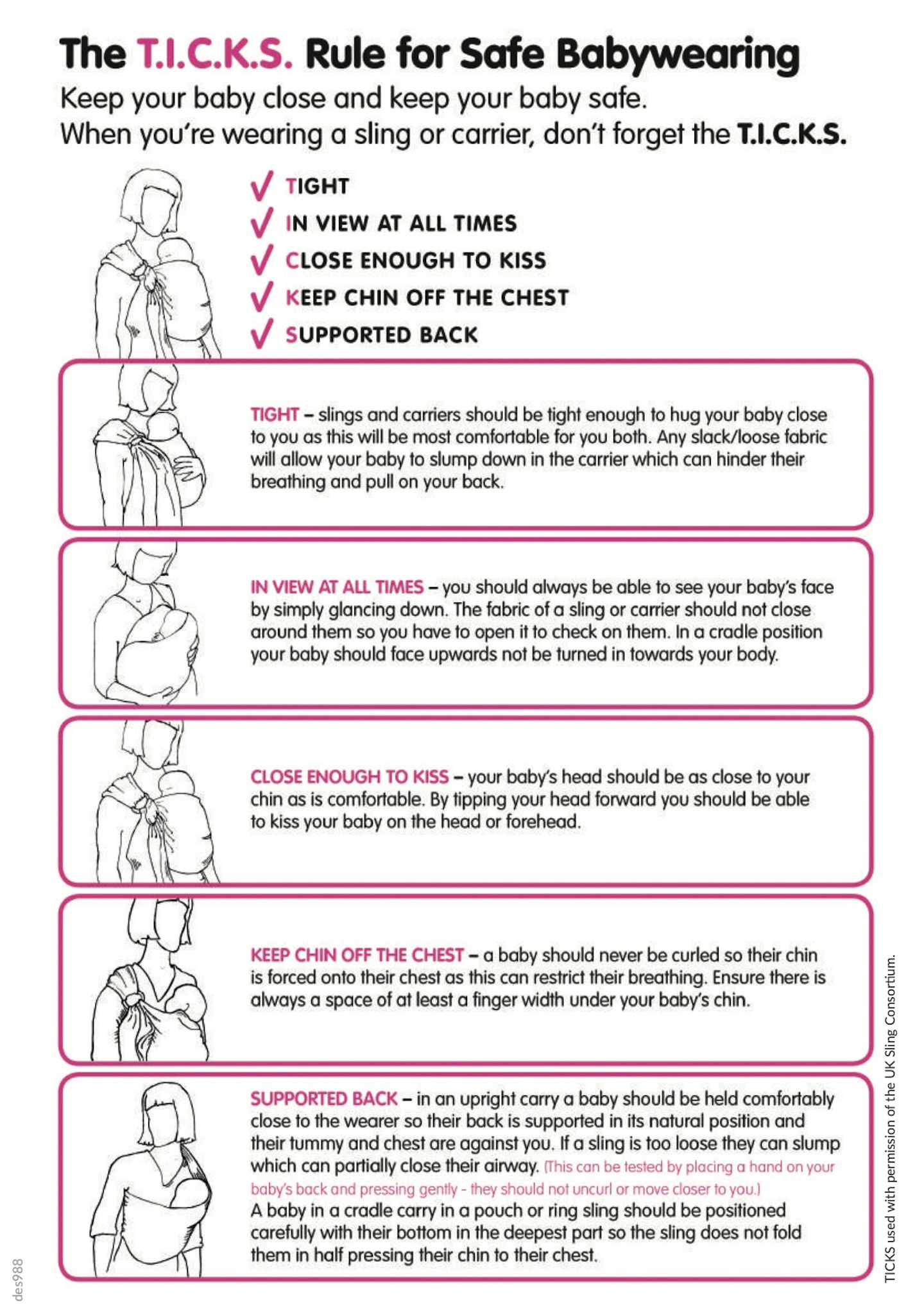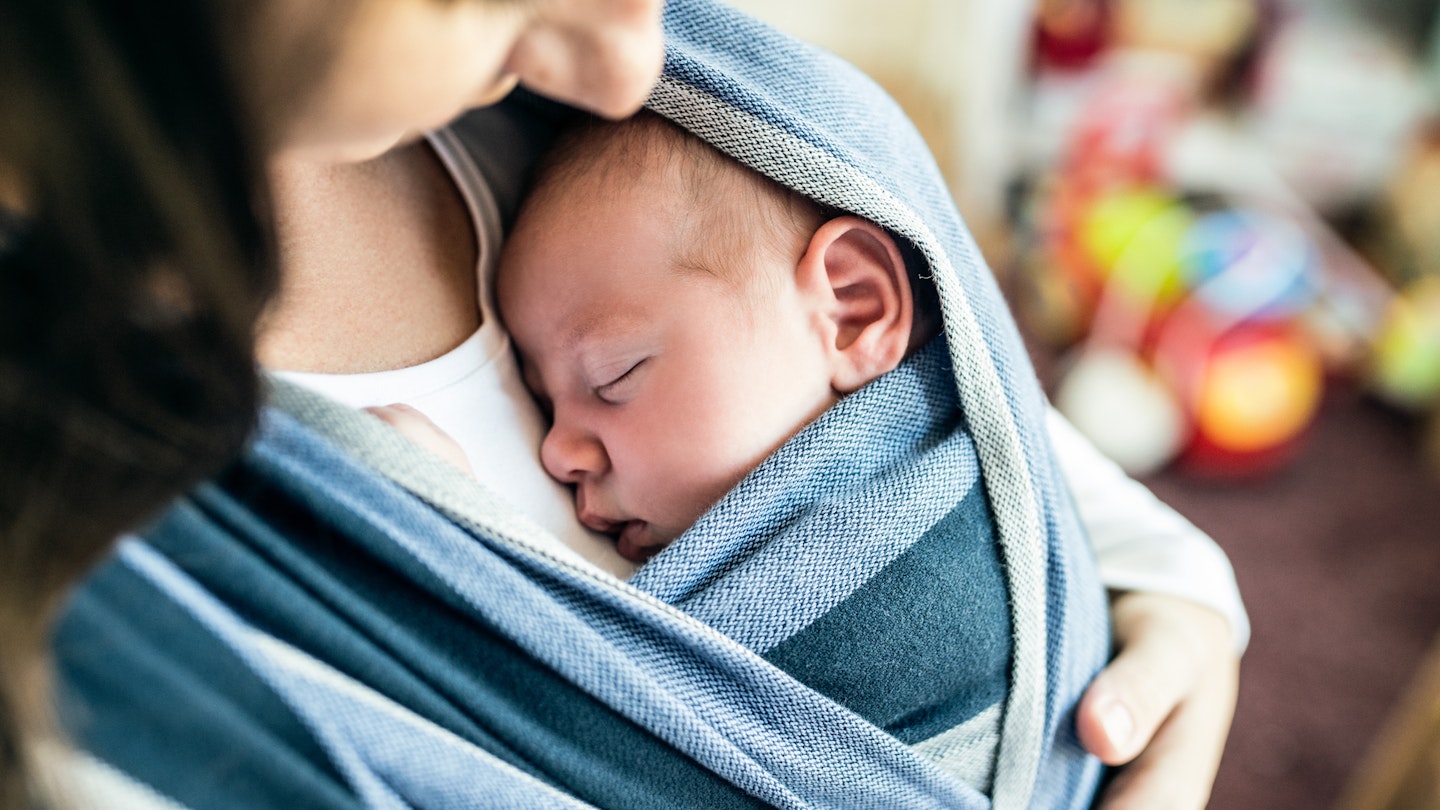If you're hearing the term "babywearing" for the first time you're probably wondering what it's all about and if babywearing is for you? And if you like the idea, the next thing you'll want to know is what on earth to do with all of that fabric, as you try to wrap yourself up with your tot and end up feeling like an egyptian mummy!
We'll explain what babywearing is and why people love it. We also talk to mum of two and babywearing expert Dr Rosie Knowles, who is not only a GP but also a carrying consultant and author of Why Babywearing Matters. Dr. Rosie explains how to use a baby wrap or sling safely, and we share even more interesting titbits - like how babywearing can also improve breastfeeding and your baby's health in general, if slings are safe for newborns and the risks involved, what babies should wear in a carrier and more.
If you thought that was everything you'd needed to know about babywearing, we've also got a quiz at the very end to help you find the right baby carrier for you! Sound good? Let's get started...
What is babywearing and why do people love it?
Constant cuddles and the gift of reclaiming your hands? It’s no wonder babywearing is growing in popularity in the UK. There are a number of benefits for both you and your little one when it comes to babywearing:
The calming effect
Slings and baby carriers are a great source of comfort to your baby for a start! Keeping them close to your chest means they can hear your heartbeat and feel your body warmth.
Plus, your movement mimics the comforting rocking motion your baby felt when they were in your womb, which means wearing your baby has a naturally calming effect on them, and in turn, on you.
It's all about the convenience
But baby carriers are about convenience too – no one enjoys manoeuvring a pram onto public transport or around busy shops and cafés, and carrying your baby or toddler in your arms can quickly become heavy and uncomfortable.
With many types of carrier available, however, it can be hard to know which one to try, and a bad first experience can leave you wondering whether babywearing is really right for you. Luckily we've got some helpful tips on how to choose a baby carrier. But first...
What's good about babywearing according to the experts?
Babywearing is an effective way of comforting an upset baby, and, as we've touched on, and it can have a relaxing effect on you as well. This is because, being close to your baby triggers your brain to release the hormone oxytocin, which will help you to feel calm and content. Oxytocin, often referred to as the ‘love hormone,’ plays a central role in early parenting. It is also released during sex, orgasm, birth and breastfeeding (Odent, 1999; Buckley, 2002) according to the NCT.
Dr Rosie Knowles says, "Mums feel better for the cuddles, but also because they become confident that they can calm their baby, meet their needs and still be hands-free to do what they want to. Babywearing is an age-old practice that helps life to work."
A study carried out at Columbia University in New York found that using a soft baby carrier from an early age helped promote a strong and secure attachment between mothers and their babies. It concluded that the increased physical contact created from using carriers made mothers more responsive to their babies' needs, which helped to promote bonding.

Some mums worry that babywearing could discourage their child from being independent and hold back their physical development, but Dr. Rosie says the opposite is actually true. "Building a happy brain that is confident and secure is essential to a child’s long-term wellbeing," says Dr. Rosie, "Most people who carry their children a lot in the early months find that this helps them feel more able to explore the world around them, as they are very sure of their parent being there when they need them."
When wearing a baby carrier, a mum or other caregiver can more easily respond to a baby's needs. Being so close allows you to become more attuned and responsive to your baby's cues, meaning that little one will feel heard and loved, which will inevitably lead to positive emotional development.
Babywearing is also a great opportunity for other members of your family to bond with baby, like the father, as fathers or other life partners can often feel a bit on the outside if they don't get to spend as much one-to-one time with little one as mum.
Safety when babywearing
In order to make babywearing an enjoyable and relaxing experience, it's important to take safety into account.
Make sure baby is safe in their carrier by following the TICKS rule:
T - is for Tight. Your carrier should be close fitting to make sure it holds your baby in a safe position.
I - is for In view at all times. Make sure you can clearly see your baby’s face so you can check on them easily.
C - is for Close enough to kiss. You should be able to kiss the top of your baby’s head easily while they are in the carrier, but make sure they can still move their head freely.
K - is for Keep chin off chest. "His chin should be off his chest and his airway open and unobstructed, and remain so if he falls asleep," says Rosie.
S - is for Supported back. ‘The sling should be snug so baby’s chest and back are well supported, with no slumping or sliding downwards,’ says Rosie.

When can baby face forward in a baby carrier?
You might also be wondering - when can baby face forward in carrier? Accordng to baby carrier experts at Ergobaby: "Once her neck muscles are strong enough to steadily support her head, typically between 4-6 months old, then you can safely face her forward in your baby carrier."
They say that around the same time your baby develops good head control they will also have started to transition from being interested in your face to wanting to look around more and see what's going on in the world. This is a good indicator that they're ready to face forwards in their baby carrier.
Are slings safe for newborns?
While slings and baby carriers may seem like the answer to all your problems as a new mum, you'd be right to want to know - are baby carriers safe? When they're not used safely, a baby sling or carrier could indeed put your baby at risk, especially when they are very young or newborn.
The Lullaby Trust says: "Although there is no reliable evidence that slings are directly associated with SIDS, there have been a number of deaths worldwide where infants have suffered a fatal accident from the use of a sling. These accidents are particularly due to suffocation, and particularly in young infants."
We don't want to scare you though, and as long as you're aware of the risks, there's no reason why you can't safely use a baby sling. Lullaby Trust says, "The risk appears to be greatest when a baby’s airway is obstructed either by their chin resting on their chest or their mouth and nose being covered by a parent’s skin or clothing."
For this reason the safest baby carrier to use, according to the Lullaby Trust, will keep the infant firmly in an upright position where you can always see your baby’s face, and ensure their airways are free.
Babies who were premature, had low birth weight, are unwell, or are under 4 months of age are at greater risk of suffocation in baby slings and carriers.
Complete guidance is available by visiting The Royal Society for the Prevention of Accidents.
How long can a baby be in a carrier?
There doesn't seem to be any clear guidelines on how long a baby can be in a carrier, so we'd advise to keep on eye on your baby's cues, and if they seem discontent, maybe give them a break. It's also important to pay attention to your own body cues, and give your muscles and joints a rest too from time to time, especially as your baby starts to grow and become heavier or want to move around more.
What should baby wear in carrier?
Deciding what to dress little one in when they are in your baby carrier or sling really depends on a number of things - like the weather and whether you're indoors or outdoors.
Wear My Baby have a handy tip: "As a rough rule of thumb when babywearing, you count as one layer of clothing for your baby, and your sling counts as at least another." They also say, "If you walk into a warm shop, house or cafe, that’s like putting a third layer on them." This should help you avoid overheating your baby when dressing them for any occasion, and is a handy tip to think about when dressing yourself too, when you will be wearing your baby in a sling or carrier during the day.

Babywearing coats can also be useful as you can wrap the coat around you and your baby, meaning little one doesn't have to wear their own coat. This also means that when you enter a shop or cafe you only have to open up your coat so that baby doesn't overheat indoors, instead of having to worry about removing a layer of baby's clothing too. Some maternity coats will also take you to post-birth. Babywearing hoodies are also a great option, and really handy for discreet breastfeeding while out and about. Don't forget about a baby carrier cover for wet days too!
How to wrap a baby sling
It can be pretty tricky to get the hang of using a baby wrap, but this mama has made it look like a breeze! As you can see from the video, she is always making sure the wrap is tied tightly around her to make sure baby is safe and secure. Buying the best baby sling for you is important too, so make sure you shop around and do your research!
How babywearing can benefit breastfeeding and your baby's health
Babywearing has also been found to benefit breastfeeding. A study carried out in Italy in 2012 found infants who spent at least an hour a day in a baby carrier during the first month breastfed more frequently at two and five months than those who weren’t carried.
One of the reasons babywearing can help breastfeeding is that it promotes skin-to-skin contact, which boosts levels of the hormones oxytocin and prolactin, both of which play an important role in ensuring your baby is ready for their next feed before they become hungry and upset. Plus, if they're spending more time in their baby carrier, the close proximity means you're more likely to breastfeed frequently due to the convenience and the fact that it is discreet while they are tucked up in the sling. Frequent breastfeeding is essential for establishing and maintaining a mother’s milk supply and ensuring optimal nutrition for the baby.
There are other health benefits, too. Close contact helps regulate your baby’s temperature, breathing and heart rate, but carrying your baby can also feel like a lifesaver if your baby suffers from colic, reflux or constipation. This is because an effective baby carrier holds your baby upright with his legs in an M position – where his knees are higher than his bottom – a position which promotes healthy digestion.
"Babies with colic can be hard to soothe, but the motion gained from being gently rocked while the parent walks often helps to settle them," says Rosie. "A good carrier encourages an upright position, which can reduce posseting and reflux, and a spread squat position helps aid bowel elimination."
With all these benefits to be gained, your next step is finding the right carrier for you…
QUIZ: How to find the best baby carrier for you

Follow our quiz to find which baby carrier is right for you.
How old is your child?
-
Under four months
-
Four to 12 months
-
12 months or older
Are you good at following instructions?
-
Yes, so long as I have clear guidance or a good YouTube video to follow
-
I like things to be quick and simple, so I can master them easily
-
I’m pretty confident at having a go at most things
What do you want to use your carrier for?
-
I want something my baby will settle easily in and which I can breastfeed in
-
Practical things like going for a long walk and getting stuff done around the house
-
Carrying my toddler when his legs are getting tired
Mostly 1's:
Many parents with young babies find a stretchy wrap a good option. It’s soft and comfortable and offers good support to your little one, so he doesn’t need to have good head control. Some find the wrapping technique confusing, and it can be tricky to get right at first.
Watch plenty of online tutorials to help you get started, or get advice from your local sling library. Or look for a newborn buckle carrier made of softer
fabric, which can be adjusted to fit your baby perfectly.
Mostly 2's:
Soft structured baby carriers or buckle carriers are quick and simple to use, and can be easily adjusted for different people or as your baby grows. Buckle carriers are ideal for babies who have good head control, but some are suitable from birth; others may need an additional insert to be used for newborns. It can be difficult to breastfeed in a soft structured carrier.
Ring slings (a piece of fabric fed through two rings) are also easy to use and are ideal for breastfeeding in, however, they can be a little uncomfortable if worn for long periods, as they don’t necessarily distribute your child’s weight evenly.
Mostly 3's:
Toddler versions of soft structured carriers are available and allow you to carry your little one on either your front or back when his legs get tired. These allow for facing you or outward facing, which helps keep wriggly, nosy toddlers entertained. They often come in a variety of materials, including lighter, mesh fabrics so that your child doesn’t get sweaty.
Ring slings can also be used for toddlers and can be folded up easily and popped into your change bag so it’s there when you need it. Some prefer to use rucksack-style back carriers for older children, but these can be very heavy and tend to take up lots of space.
Meet the expert
Dr Rosie Knowles is a practising GP in the UK with a particular interest in holistic medicine as well as children and women’s health and perinatal and infant mental health. Dr. Rosie is also a Carrying Consultant at carryingmatters.co.uk, lecturing widely around the UK and Europe, and offers babywearing training courses. She is also the Author of her book, “Why Babywearing Matters”, published by Pinter and Martin in May 2016, and has written for a wide range of publications and won several awards.
Proud aunt to her teen niece, Zara Mohammed is a Digital Writer for Mother&Baby. She has 10 years freelance writing experience creating lifestyle content for various platforms, including pregnancy, women’s health, parenting, child development and child mental health, plus lots of fun seasonal family articles and celebrity news.
